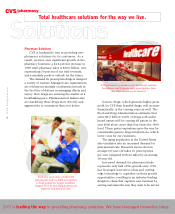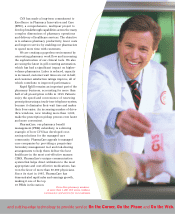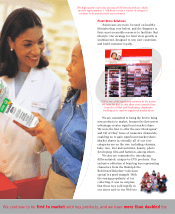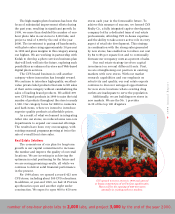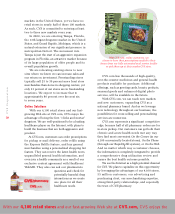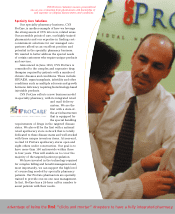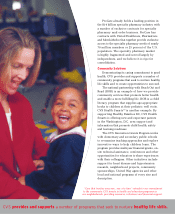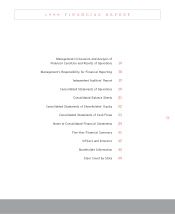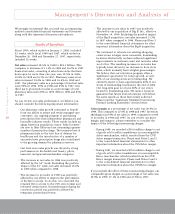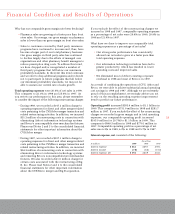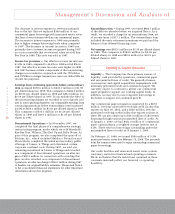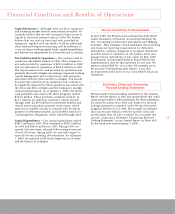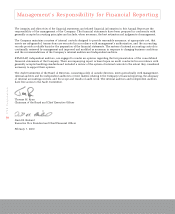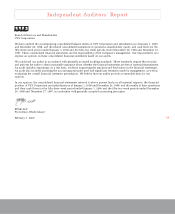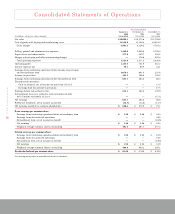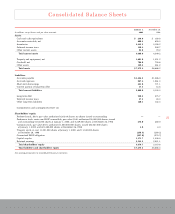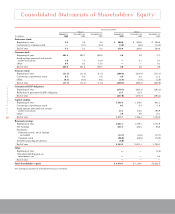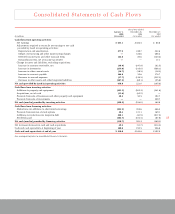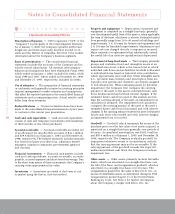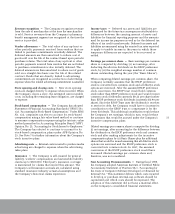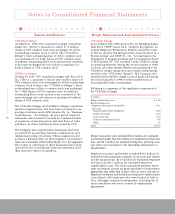CVS 1999 Annual Report Download - page 18
Download and view the complete annual report
Please find page 18 of the 1999 CVS annual report below. You can navigate through the pages in the report by either clicking on the pages listed below, or by using the keyword search tool below to find specific information within the annual report.
16
CVS Corporation
The decrease in interest expense in 1999 was primarily
due to the fact that we replaced $300 million of our
commercial paper borrowings with unsecured senior notes
that bear a lower interest rate than our commercial paper.
The increase in interest expense in 1998 was primarily
due to higher average borrowing levels when compared
to 1997. The decrease in interest income in 1998 was
primarily due to interest income recognized during 1997
on a note receivable that we received when we sold Kay-
Bee Toys in 1996. This note was sold in 1997.
Income tax provision ~ Our effective income tax rate was
41.0% in 1999 compared to 44.4% in 1998 and 62.8% in
1997. Our effective income tax rates were higher in 1998
and 1997 because certain components of the nonrecurring
charges we recorded in conjunction with the CVS/Arbor
and CVS/Revco merger transactions were not deductible for
income tax purposes.
Earnings from continuing operations before extraordinary
item increased $250.6 million to $635.1 million (or $1.55
per diluted share) in 1999. This compares to $384.5 million
(or $0.95 per diluted share) in 1998 and $88.4 million (or
$0.19 per diluted share) in 1997. If you exclude the effect of
the nonrecurring charges we recorded in cost of goods sold
and in total operating expenses, our comparable earnings from
continuing operations before extraordinary item increased
24.5% to $635.1 million (or $1.55 per diluted share) in 1999.
This compares to $510.1 million (or $1.26 per diluted
share) in 1998 and $419.2 million (or $1.05 per diluted
share) in 1997.
Discontinued Operations ~ In November 1997, we
completed the final phase of a comprehensive strategic
restructuring program, under which we sold Marshalls,
Kay-Bee Toys, Wilsons, This End Up and Bob’s Stores. As
part of this program, we also completed the spin-off of
Footstar, Inc., which included Meldisco, Footaction and
Thom McAn, completed the initial and secondary public
offerings of Linens ‘n Things and eliminated certain
corporate overhead costs. During 1997, we sold our
remaining investment in Linens ‘n Things and recorded,
as a component of discontinued operations, an after-tax
gain of $38.2 million. In connection with recording this
gain, we also recorded, as a component of discontinued
operations, an after-tax charge of $20.7 million during 1997
to finalize our original liability estimates. Please read Note 4
to the consolidated financial statements for other important
information about this program.
Extraordinary item ~ During 1997, we retired $865.7 million
of the debt we absorbed when we acquired Revco. As a
result, we recorded a charge for an extraordinary item, net
of income taxes, of $17.1 million. The extraordinary item
included the early retirement premiums we paid and the
balance of our deferred financing costs.
Net earnings were $635.1 million (or $1.55 per diluted share)
in 1999. This compares to $384.5 million (or $0.95 per
diluted share) in 1998 and $88.8 million (or $0.19 per
diluted share) in 1997.
Liquidity & Capital Resources
Liquidity ~ The Company has three primary sources of
liquidity: cash provided by operations, commercial paper
and uncommitted lines of credit. We generally finance
our inventory and capital expenditure requirements with
internally generated funds and commercial paper. We
currently expect to continue to utilize our commercial
paper program to support our working capital needs. In
addition, we may elect to use long-term borrowings in
the future to support our continued growth.
Our commercial paper program is supported by a $670
million, five-year unsecured revolving credit facility that
expires on May 30, 2002, and a $530 million, 364-day
unsecured revolving credit facility that expires on June 21,
2000. We can also obtain up to $35.0 million of short-term
financing through various uncommitted lines of credit. As
of January 1, 2000, we had $451.0 million of commercial
paper outstanding at a weighted average interest rate of
6.2%. There were no borrowings outstanding under the
uncommitted lines of credit as of January 1, 2000.
On February 11, 1999, we issued $300 million of 5.5%
unsecured senior notes due February 15, 2004. The proceeds
from the issuance were used to repay outstanding commercial
paper borrowings.
Our credit facilities and unsecured senior notes contain
customary restrictive financial and operating covenants.
We do not believe that the restrictions contained in these
covenants materially affect our financial or operating
flexibility.
Management’s Discussion and Analysis of


